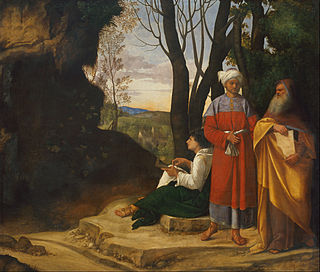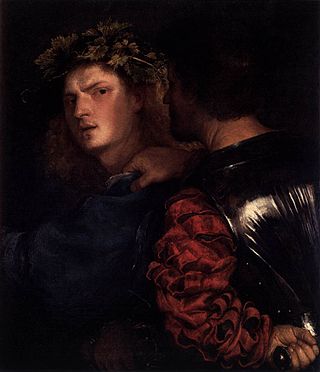
David Teniers the Younger or David Teniers II was a Flemish Baroque painter, printmaker, draughtsman, miniaturist painter, staffage painter, copyist and art curator. He was an extremely versatile artist known for his prolific output. He was an innovator in a wide range of genres such as history painting, genre painting, landscape painting, portrait and still life. He is now best remembered as the leading Flemish genre painter of his day. Teniers is particularly known for developing the peasant genre, the tavern scene, pictures of collections and scenes with alchemists and physicians.

The Three Philosophers is an oil painting on canvas attributed to the Italian High Renaissance artist Giorgione. It shows three philosophers – one young, one middle-aged, and one old.

The Stallburg is a renaissance-style building in the Vienna city center located between Josefsplatz and Michaelerplatz. It is part of the Hofburg Palace.

Violante is an oil on panel painting attributed to Titian, dated to c. 1515. It is held at the Kunsthistorisches Museum, in Vienna.

The Portrait of Jacopo Strada is an oil on canvas portrait of the court librarian Jacopo Strada by Titian, from 1567-1568. It is held in the Kunsthistorisches Museum, in Vienna.

Abraham Teniers was a Flemish painter and engraver who specialized in genre paintings of villages, inns and monkey scenes. He was a member of artist family Teniers which came to prominence in the 17th century. He was also active as a publisher.

The Madonna of the Cherries is a 1515 painting by Titian, heavily influenced by the work of Giovanni Bellini. Originally oil on wood, it was later transferred to canvas. During the 17th century it formed part of the collection of Archduke Leopold Wilhelm, where it was copied by David Teniers. It is now in the Kunsthistorisches Museum, in Vienna.

The Bravo is an oil painting usually attributed to Titian, dated to around 1516-17 and now in the Kunsthistorisches Museum in Vienna. The painting can be seen as one of a number of Venetian paintings of the 1510s showing two or three half-length figures with heads close together, often with their expressions and interactions enigmatic. Most of these are "Giorgionesque" genre or tronie subjects where the subjects are anonymous, though the group includes Titian's The Tribute Money, with Christ as the main figure, which in terms of style is similar to this painting, and his Lucretia and her Husband, also in Vienna, where at least the woman's identity is clear, if not that of the man.

Theatrum Pictorium, or Theatre of Painting, is a short-hand name of a book published in the 1660s by David Teniers the Younger for his employer, the Archduke Leopold Wilhelm of Austria. It catalogs 243 Italian paintings in the Archduke's collection of over 1300 paintings. The paintings are reproduced by engravings made by various engravers after reduced-size copies (modelli) created by Teniers. David Teniers' brother Abraham Teniers was involved in organizing the publication of the work. A second edition with page numbers was published in 1673.

Jan van Troyen was a Flemish engraver and etcher. He is mainly known for the work he did for David Teniers the Younger on the illustrations for the Theatrum Pictorium, an publication which gave an overview of the paintings in the collection of the Archduke Leopold Wilhelm.

Judith with the head of Holofernes is a 1610–1615 painting by the painter Carlo Saraceni, now held in the Kunsthistorisches Museum in Vienna.

Saint Margaret and the Dragon is the title shared by two paintings of Saint Margaret by the Renaissance painter Raphael, both executed in about 1518. One is held in the Kunsthistorisches Museum in Vienna, the other in the Louvre in Paris.

Gallery of Archduke Leopold Wilhelm in Brussels is a 1651 painting of Archduke Leopold Wilhelm's Italian art collection by the Flemish Baroque painter David Teniers the Younger, now held in Petworth House in England.

Archduke Leopold Wilhelm and the artist in the archducal picture gallery in Brussels is a 1651 painting of Archduke Leopold Wilhelm's Italian art collection by the Flemish Baroque painter David Teniers the Younger, now held in the Kunsthistorisches Museum in Vienna.

Archduke Leopold Wilhelm and the artist in the archducal picture gallery in Brussels is a 1653 painting of Archduke Leopold Wilhelm's Italian art collection by the Flemish Baroque painter David Teniers the Younger. It is now held in a private collection, but it was previously owned by the Rothschild family, from whom it was taken in World War II and placed in the Kunsthistorisches Museum where it stayed for 50 years until restitution in 1999.

Archduke Leopold Wilhelm and the artist in the archducal picture gallery in Brussels is a 1653 painting of Archduke Leopold Wilhelm's Italian art collection by the Flemish Baroque painter David Teniers the Younger, now held in the collection of Museo Lázaro Galdiano in Madrid.

Gallery of Archduke Leopold Wilhelm in Brussels is a 1651 painting of Archduke Leopold Wilhelm's Italian art collection by the Flemish Baroque painter David Teniers the Younger, now in the Royal Museums of Fine Arts of Belgium.

Gallery of Archduke Leopold Wilhelm in Brussels is a painting of Archduke Leopold Wilhelm's Italian art collection by the Flemish Baroque painter David Teniers the Younger, now held in the Schleissheim Palace. It dates to the 1650s.

Rest on the Flight into Egypt is a c. 1508 oil on panel painting by Titian, owned by the Marquess of Bath and held at Longleat House near Warminster, Wiltshire, England. The artwork portrays Joseph, Mary, and Jesus as they stop to rest during their flight into Egypt.

Christ and the Adulteress, also titled Christ and the Woman Taken in Adultery, or The Adulteress before Christ, is an oil painting by Titian, made about 1520, in the Kunsthistorisches Museum, Vienna, depicting Jesus and the woman taken in adultery.





















































